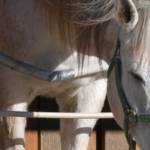Vitamin D in Equine Diets

Vitamin D is actually a hormone, and adequate sunlight results in the production of sufficient vitamin D from 7-dehydrocholesterol in the skin. Hence, vitamin D is not required in the diet if sufficient amounts of sunlight are received. Sufficient vitamin D must be present for calcium and phosphorus to be absorbed; a vitamin D deficiency markedly reduces absorption of both minerals. Lack of adequate photoproduction of vitamin D3 or inadequate dietary supplementation of vitamin D can lead to the failure of bones to calcify normally. This metabolic disease is known as rickets in young horses and osteomalacia in adults.
The two major natural sources of vitamin D are cholecalciferol (D3, which occurs in animals) or ergocalciferol (D2, which occurs predominantly in plants). Vitamin D2 and D3 are not equally utilized by the horse; it appears that D3 may be many times more potent a source than D2.
Vitamin D3 produced in the skin goes to the liver. Dietary vitamins D2 and D3 are absorbed in the distal small intestine. The absorbed vitamin D is transported via the lymph-blood system to the liver where it is hydroxylated to 25-hydroxycholecalciferol. This form is then secreted back into the blood stream where it is further hydroxylated in the kidney to one of two forms, either 1,25-dihydroxycholecalciferol or 24,25-dihydroxycholecalciferol. The conversions of these vitamin D metabolites are under hormonal control. Low blood calcium stimulates the secretion of parathyroid hormone (PTH), which in turn stimulates the release of these metabolites. Vitamin D metabolites have a three-fold effect: an increase in the absorption of calcium, phosphorus, and magnesium in the intestines, an increase in the release of calcium and phosphorus from the bone, and an increase in the resorption of calcium in the kidney.
Vitamin D3 (cholecalciferol) results primarily from ultraviolet irradiation of 7-dehydrocholesterol synthesized by the tissues of the horse and present in the skin. The vitamin is then transported to the liver for utilization.
Vitamin D2 (ergocalciferol) results from ultraviolet irradiation of ergosterol, which is synthesized by plants. This process does not occur until the plant has been cut and is exposed to sunlight. Leaves have a higher concentration of D2 than stems.
Foods naturally rich in vitamin D3 include fish oils and egg yolks. Sun-cured forages have high levels of vitamin D2. Hays that have been dried artificially with little exposure to sunlight will not contain much vitamin D. Many commercial horse feeds include vitamin D in the formulation in case the animals are not receiving enough of the nutrient from other sources.
Modern horsemanship practices may predispose the horse to suboptimal intakes of vitamin D. Restricting the amount of turnout for horses to less than two hours a day prevents their bodies from having time to convert sufficient vitamin D in the skin. In addition, during winter, conversion is less efficient because of the lower intensity of light and is further compounded by the use of blankets covering much of their bodies. During summer, horses tend to be turned out at night when it is cool and kept inside when the sun is shining.
Supplementation with 800 to 1000 IU of vitamin D per kg of dry diet has been found to be adequate to prevent deficiency symptoms in growing horses. Supplementation at this level with no exposure to sunlight does not produce bones as strong as those in a horse that is maintained outside. Optimal supplementation for horses with limited access to sunlight is not yet known.
Extensive bone remodeling has been found in young horses undergoing race training resulting in changes in calcium, phosphorus and vitamin D levels in serum and bone. Logically, anything that stresses the bone structure of the animal (such as carrying the weight of the rider, jumping, or intensive training) will increase the amount of bone remodeling, and therefore may increase the need for vitamin D. An increase in vitamin D intake has been found to increase efficiency of calcium and phosphorus absorption in the intestinal tract which would increase the supply of these nutrients as needed in times of stress due to exercise.
Outward signs of vitamin D toxicosis are depression, decreased appetite with weight loss, and limb stiffness. One study found that when young ponies were fed 14,000 IU vitamin D per kg body weight daily, acute toxicity and severe calcification of the lungs, heart, kidney and other organs occurred within 10 days. Chronic toxicity (calcification of kidneys, rarefication of bone, severe weight loss and death after 3 to 4 months) occurred when 3500 IU vitamin D per kg of body weight per day was fed. The tolerable dose varies with the intake of calcium and possibly other nutrients which influence calcium metabolism, such as phosphorus, magnesium, protein and vitamin A.








